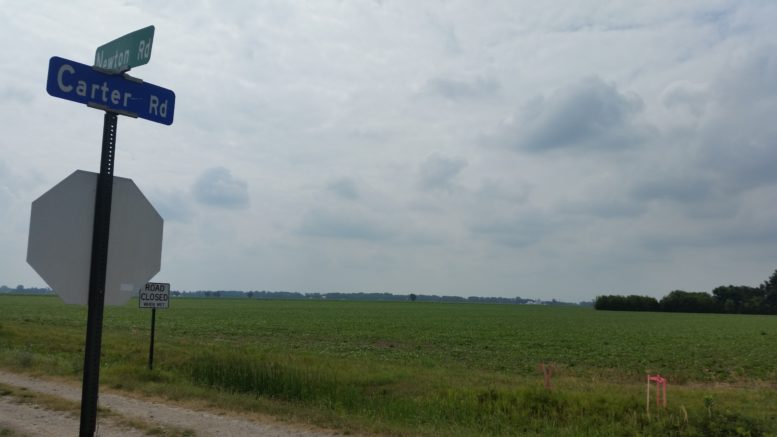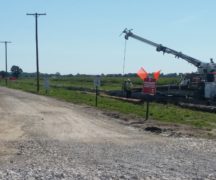By JAN LARSON McLAUGHLIN
BG Independent News
Mayor Dick Edwards was beaming as he announced that the recent sunny days have led to some good numbers at the Bowling Green solar field – the largest solar installation in Ohio.
On the best day so far, the solar field generated 19.6 megawatts of energy.
“The sun is cooperating,” Edwards said during Monday’s City Council meeting.
The 165-acre solar field, located at the corner of Newton and Carter roads, northeast of the city, consists of more than 85,000 solar panels and is capable of producing 20-megawatts of alternating current electricity.
In an average year, the solar field is expected to produce an equivalent amount of energy needed to power approximately 3,000 homes. It will also avoid approximately 25,500 metric tons of carbon dioxide emissions per year since the energy is generated from a non-fossil fuel resource.
“That’s an amazing factoid there,” Edwards said.
Along with sustainable benefits, the project will also have economic benefits for the city, according to city officials. By having the generation supplied “behind the meter,” the city will see lower capacity and transmission charges, as well as on-peak energy delivered at times when customer demand for electricity is highest.
“We are excited to see this project come online and start delivering power to our customers,” Bowling Green Utilities Director Brian O’Connell said. “Like the wind turbine project, we are looking forward to many years of a local and renewable resource.”
The site was built and is owned and operated by a subsidiary of NextEra Energy Resources LLC. The power generated will be sold to American Municipal Power Inc. under a multi-year contract. AMP will then sell this clean energy to the city and other participating AMP member utilities. AMP partnered with NextEra to construct and operate up to 80 MW of new solar generation in other member communities. Additional solar sites are already under construction and more are planned in Ohio, Michigan and Delaware.
“Great work to you and your staff,” Council President Mike Aspacher said to O’Connell. “Obviously it’s a project we’re all proud of.”
Also at Monday’s meeting, council members revisited last week’s discussion on city zoning rules, which was part of the Community Action Plan process.
Council member Bruce Jeffers suggested that it would be a good idea for council to identify the CAP goals first, before working to revise the zoning code.
Council member Bob McOmber mentioned the high cost of doing major revisions to the zoning ordinance. The consultant hired to do the city’s community action plan said a complete overhaul of zoning can cost up to $300,000 and take up to three years.
“Obviously, we don’t have that kind of money readily available,” McOmber said.
Council member John Zanfardino said that even though the CAP consultants don’t recommend doing piecemeal work on the zoning, there may be some more critical items such as non-conforming zoning or signage that the city can handle first.
Council member Sandy Rowland said the city may want to focus first on zoning enforcement. “That’s the biggest complaint we get,” she said.
City Planning Director Heather Sayler told council that the city may be able to tackle some gaps in its zoning code. She suggested that the costs mentioned are probably reflective of larger cities.
In other business, council approved the city fire division’s five-year strategic plan. Edwards noted the “dramatic reduction” in unnecessary fire runs to Bowling Green State University thanks to education efforts.
“This is really saving a lot of wear and tear on our equipment,” he said.
Municipal Administrator Lori Tretter reported that city employees reaching five-year milestones were recently recognized during a breakfast. She also noted that McOmber has attended every annual employee recognition breakfast during his 12 years on council.
“I don’t think there’s anything more important that I can do,” than show how much he values city employees, McOmber said. “I would put our employees up against any employees.”
Also at the meeting, Police Chief Tony Hetrick talked about two grants recently received by the police division. A Department of Justice grant of nearly $11,000 will be used to put in-car video cameras in three cruisers.
Hetrick said a detective was recently sent to a training program on recovery of digital evidence. The police division received a $46,000 grant for digital software and hardware that will be made available to regional law enforcement.
In other business, citizen Jennifer Karches voiced her concerns about plans for the city’s green space located at the corner of West Wooster and South Church streets. She questioned the “traditional” plans for the site, and suggested the design will not attract the city’s target demographic. Karches asked why there wasn’t more public input allowed.
Edwards said the green space design effort has been a very public process. The design is very basic, he said, with a gazebo, walkways and plantings.
“It will be a very open process. It has been,” an open process, the mayor said. “I’ve heard nothing but strong, positive comments.”
Also at Monday’s meeting:
- Edwards talked about the city’s Winterfest activities planned for this weekend.
- Parks and Recreation Director Kristin Otley said three splash pad creatures will be ordered for the city pool, thanks to $24,000 raised in grants and donations.
- Public Works Director Brian Craft said the new traffic light at South Main Street and Gypsy Lane Road is fully operational. Of the $950,000 cost, $750,000 came from TIF funding. Napoleon Road reconstruction will also be assisted by $332,000 in TIF funding.
- Craft reported a new traffic light will be installed at the intersection of West Poe Road and Fairview Avenue.
- Members of Cub Scout Pack 422, from Conneaut Elementary, attended the council meeting.




